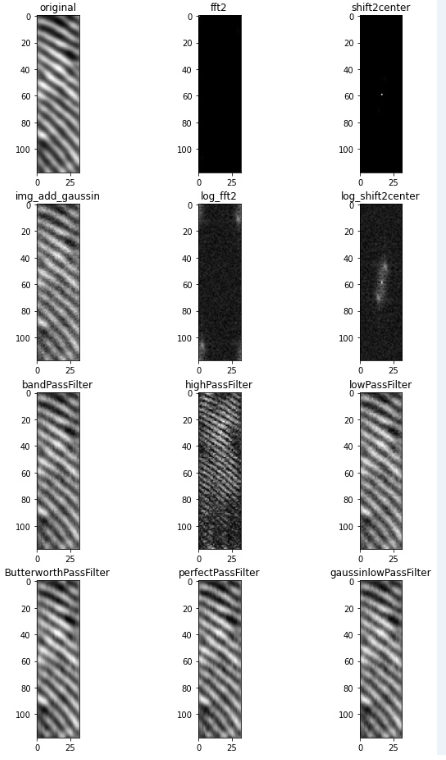目录
低通滤波器---Butterworth低通滤波器、理想低通滤波器、高斯低通滤波器
加载图像添加噪声
- 高斯噪声是指它的概率密度函数服从高斯分布(即正态分布)的一类噪声
- 椒盐噪声也称为脉冲噪声,是图像中经常见到的一种噪声,它是一种随机出现的白点或者黑点,可能是亮的区域有黑色像素或是在暗的区域有白色像素(或是两者皆有)
- 乘性噪声一般由信道不理想引起,它们与信号的关系是相乘,信号在它在,信号不在他也就不在
import numpy as np
import cv2
import matplotlib.pyplot as plt
import skimage
from skimage import io
import random
#img = cv2.imread('E:/python/CSDN/image/1.bmp',cv2.IMREAD_GRAYSCALE)
img = plt.imread('E:/python/CSDN/image/5.bmp')
fig=plt.figure(figsize=(10, 50))
#显示原图
plt.subplot(12,3,1),plt.imshow(img,'gray'),plt.title('original')
def addGaussNoise(origin,var=0.0005):#添加高斯噪声函数
#var = random.uniform(0.0001, 0.04)
noisy = skimage.util.random_noise(origin, mode='gaussian', var=var)
return noisy
def addSaltNoise(origin,var=0.01):#添加椒盐噪声函数
#var = random.uniform(0.01, 0.2)
noisy = skimage.util.random_noise(origin, mode='s&p', amount=var)
return noisy
def addSpeckleNoise(origin,var=0.001):#添加乘法噪声函数
#var = random.uniform(0.0001, 0.04)
noisy = skimage.util.random_noise(origin, mode='speckle', var=var)
return noisy
img = addGaussNoise(img)
#img = addSaltNoise(img)
#img = addSpeckleNoise(img)
#显示添加高斯噪声的原图
plt.subplot(12,3,4),plt.imshow(img,'gray'),plt.title('img_add_gaussin')图像傅里叶变换和反变换并可视化
#进行傅立叶变换,并显示结果
fft2 = np.fft.fft2(img)
plt.subplot(12,3,2),plt.imshow(np.abs(fft2),'gray'),plt.title('fft2')
#将图像变换的原点移动到频域矩形的中心,并显示效果
shift2center = np.fft.fftshift(fft2)
plt.subplot(12,3,3),plt.imshow(np.abs(shift2center),'gray'),plt.title('shift2center')
#保存图片
#cv2.imwrite("E:/python/CSDN/image/fft.jpg",np.abs(fft2))
#cv2.imwrite("E:/python/CSDN/image/fftshift.jpg",np.abs(shift2center))
#由于傅里叶系数的动态范围过大,无法在屏幕上显示,为了便于观察,利用对数变换将这些较大的系数值变小。经过对数变换之后,较高的数值会变成白点,而较小的数值变为黑点。为了将灰度值可视化。
#对傅立叶变换的结果进行对数变换,并显示效果
log_fft2 = np.log(1 + np.abs(fft2))
plt.subplot(12,3,5),plt.imshow(log_fft2,'gray'),plt.title('log_fft2')
#对中心化后的结果进行对数变换,并显示结果
log_shift2center = np.log(1 + np.abs(shift2center))
plt.subplot(12,3,6),plt.imshow(log_shift2center,'gray'),plt.title('log_shift2center')
#原图反变换
f_image = np.fft.ifftshift(shift2center)
image_new = np.fft.ifft2(f_image) # 反变换的结果是复数
image_new = np.abs(image_new)图像处理---高通滤波、低通滤波、带通滤波
- ??? 高通滤波:高频信息通过,低频信息被阻挡;
- ? ? 低通滤波:低频信息通过,高频信息被阻挡;
- ? ? 带通滤波:介于低频和高频之间的一带信息通过,其它信息被阻挡;
#区域越小越接近原图
up_high = 10
left_high = 15
# 掩膜-中心为0-高通滤波
rows,cols = img.shape
print("high pass{},{}".format(rows,cols))
mask0 = np.ones(img.shape)
mask0[int(rows/2-up_high):int(rows/2+up_high), int(cols/2-left_high):int(cols/2+left_high)] = 0
fshift_mask0 = shift2center*mask0
#plt.subplot(12,3,8),plt.imshow(np.abs(fshift_mask0),'gray'),plt.title('fshift_mask0')
# 二维傅里叶反变换
f_image_mask0 = np.fft.ifftshift(fshift_mask0)
image_new0 = np.fft.ifft2(f_image_mask0) # 反变换的结果是复数
image_new0 = np.abs(image_new0)
plt.subplot(12,3,8),plt.imshow(np.abs(image_new0),'gray'),plt.title('highPassFilter')
#保存图片
#cv2.imwrite("E:/python/CSDN/image/fshift_mask_high.jpg",np.abs(fshift_mask0))
#cv2.imwrite("E:/python/CSDN/image/image_new_high.jpg",np.abs(image_new0))
#区域越大越接近原图
up_low = 50
left_low = 15
# 掩膜-中心为1-低通滤波
rows,cols = img.shape
print("low pass {},{}".format(rows,cols))
mask1 = np.zeros(img.shape)
mask1[int(rows/2-up_low):int(rows/2+up_low), int(cols/2-left_low):int(cols/2+left_low)] = 1
fshift_mask1 = shift2center*mask1
#plt.subplot(12,3,10),plt.imshow(np.abs(fshift_mask1),'gray'),plt.title('fshift_mask1')
# 二维傅里叶反变换
f_image_mask1 = np.fft.ifftshift(fshift_mask1)
image_new1 = np.fft.ifft2(f_image_mask1) # 反变换的结果是复数
image_new1 = np.abs(image_new1)
plt.subplot(12,3,9),plt.imshow(np.abs(image_new1),'gray'),plt.title('lowPassFilter')
# 带通滤波
w = 50 #带宽
radius = 20 #带中心到频率平面原点的距离
rows,cols = img.shape
print("low pass {},{}".format(rows,cols))
mask1 = np.ones(img.shape)
for i in range(0, rows):
for j in range(0, cols):
# 计算(i, j)到中心点的距离
from math import sqrt
d = sqrt(pow(i - rows, 2) + pow(j - cols, 2))
if radius - w / 2 < d < radius + w / 2:
mask1[i, j] = 0
else:
mask1[i, j] = 1
fshift_mask1 = shift2center*mask1
#plt.subplot(12,3,10),plt.imshow(np.abs(fshift_mask1),'gray'),plt.title('fshift_mask1')
# 二维傅里叶反变换
f_image_mask1 = np.fft.ifftshift(fshift_mask1)
image_new1 = np.fft.ifft2(f_image_mask1) # 反变换的结果是复数
image_new1 = np.abs(image_new1)
plt.subplot(12,3,7),plt.imshow(np.abs(image_new1),'gray'),plt.title('bandPassFilter')低通滤波器---Butterworth低通滤波器、理想低通滤波器、高斯低通滤波器
低通滤波器的功能是让低频率通过而滤掉或衰减高频,其作用是过滤掉包含在高频中的噪声。即低通滤波的效果是图像去噪声平滑增强,但同时也抑制了图像的边界即过滤掉图像细节,造成图像不同程序上的模糊。
- 理想低通滤波器的滤波非常尖锐
- 高斯低通滤波器的滤波则非常平滑
- 巴特沃斯滤波器介于两者之间,当巴特沃斯低通滤波器的阶数较高时,接近于理想低通滤波器;当巴特沃斯低通滤波器的阶数较高时,则接近于高斯低通滤波器。
# Butterworth低通滤波器的实现函数的定义
def ButterworthPassFilter(image, d, n): # 定义一个Butterworth低通滤波器
f = np.fft.fft2(image) # 快速傅里叶变换算法得到频率分布
fshift = np.fft.fftshift(f) # 将图像中的低频部分移动到图像的中心,默认是在左上角
# fft结果是复数, 其绝对值结果是振幅;取对数的目的是将数据变换到0~255
fimg = np.log(np.abs(fshift))
def make_transform_matrix(d):
# 创建一个与输入图像同大小的全0矩阵,用于存储变化后的图像
transform_matrix = np.zeros(image.shape)
# 中心点值的计算,元组形式
center_point = tuple(map(lambda x: (x - 1) / 2, fimg.shape))
for i in range(transform_matrix.shape[0]): # 行遍历
for j in range(transform_matrix.shape[1]): # 列遍历
def cal_distance(pa, pb): # 欧拉距离计算函数的定义
from math import sqrt
dis = sqrt((pa[0] - pb[0]) ** 2 + (pa[1] - pb[1]) ** 2)
return dis
dis = cal_distance(center_point, (i, j)) # 求出每个点与中心点的距离
# 巴特沃斯低通滤波的数学公式实现
transform_matrix[i, j] = 1 / (1 + (dis / d) ** (2 * n))
return transform_matrix
d_matrix = make_transform_matrix(d) # 调用自定义函数
new_img = np.abs(np.fft.ifft2(np.fft.ifftshift(fshift * d_matrix))) # 生成新图
return new_img
print("ButterworthPassFilter {}".format(img.shape))
butter_25_5 = ButterworthPassFilter(img,15, 5) # Butterworth低通滤波处理
plt.subplot(12,3,10),plt.imshow(butter_25_5,'gray'),plt.title('ButterworthPassFilter')
#cv2.imwrite("E:/python/CSDN/image/ButterworthPassFilter.jpg",butter_25_5)
# 理想低通滤波器的实现函数的定义
def perfectPassFilter(image, d): # 定义一个理想低通滤波器
f = np.fft.fft2(image) # 快速傅里叶变换算法得到频率分布
fshift = np.fft.fftshift(f) # 将图像中的低频部分移动到图像的中心,默认是在左上角
# fft结果是复数, 其绝对值结果是振幅;取对数的目的是将数据变换到0~255
fimg = np.log(np.abs(fshift))
def make_transform_matrix(d):
# 创建一个与输入图像同大小的全0矩阵,用于存储变化后的图像
transform_matrix = np.zeros(image.shape)
# 中心点值的计算,元组形式
center_point = tuple(map(lambda x: (x - 1) / 2, fimg.shape))
for i in range(transform_matrix.shape[0]): # 行遍历
for j in range(transform_matrix.shape[1]): # 列遍历
def cal_distance(pa, pb): # 欧拉距离计算函数的定义
from math import sqrt
dis = sqrt((pa[0] - pb[0]) ** 2 + (pa[1] - pb[1]) ** 2)
return dis
dis = cal_distance(center_point, (i, j)) # 求出每个点与中心点的距离
# 理想低通滤波
if dis<=d: #根据理想低通滤波器产生公式,当D(i,j)<=D0,置为1
transform_matrix[i, j] = 1
return transform_matrix
d_matrix = make_transform_matrix(d) # 调用自定义函数
new_img = np.abs(np.fft.ifft2(np.fft.ifftshift(fshift * d_matrix))) # 生成新图
return new_img
print("perfectPassFilter {}".format(img.shape))
perfectPass = perfectPassFilter(img,20) # 理想低通滤波处理
plt.subplot(12,3,11),plt.imshow(perfectPass,'gray'),plt.title('perfectPassFilter')
#cv2.imwrite("E:/python/CSDN/image/perfectPassFilter.jpg",perfectPass)
# 高斯低通滤波器的实现函数的定义
def gaussinlowPassFilter(image, d): # 定义一个高斯低通滤波器
f = np.fft.fft2(image) # 快速傅里叶变换算法得到频率分布
fshift = np.fft.fftshift(f) # 将图像中的低频部分移动到图像的中心,默认是在左上角
# fft结果是复数, 其绝对值结果是振幅;取对数的目的是将数据变换到0~255
fimg = np.log(np.abs(fshift))
def make_transform_matrix(d):
# 创建一个与输入图像同大小的全0矩阵,用于存储变化后的图像
transform_matrix = np.zeros(image.shape)
# 中心点值的计算,元组形式
center_point = tuple(map(lambda x: (x - 1) / 2, fimg.shape))
for i in range(transform_matrix.shape[0]): # 行遍历
for j in range(transform_matrix.shape[1]): # 列遍历
def cal_distance(pa, pb): # 欧拉距离计算函数的定义
from math import sqrt
dis = sqrt((pa[0] - pb[0]) ** 2 + (pa[1] - pb[1]) ** 2)
return dis
dis = cal_distance(center_point, (i, j)) # 求出每个点与中心点的距离
# 高斯低通滤波
from math import exp
transform_matrix[i, j] = exp(-(dis*dis)/(2*(d**2))); #根据高斯低通滤波器公式H(u,v)=e^-[D^2(u,v)/2*D0^2]
return transform_matrix
d_matrix = make_transform_matrix(d) # 调用自定义函数
new_img = np.abs(np.fft.ifft2(np.fft.ifftshift(fshift * d_matrix))) # 生成新图
return new_img
print("gaussinlowPassFilter {}".format(img.shape))
gaussinlowPassFilter = gaussinlowPassFilter(img,20) # 高斯低通滤波处理
plt.subplot(12,3,12),plt.imshow(gaussinlowPassFilter,'gray'),plt.title('gaussinlowPassFilter')?各阶段图像示例:

?